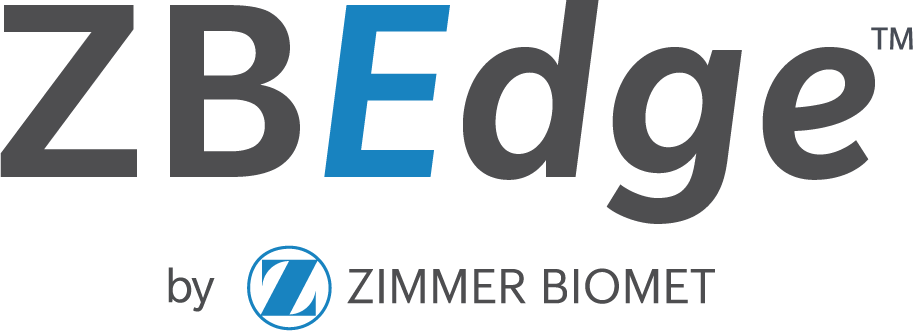

Supporting Evidence


ZBEdge is a suite of integrated digital and robotic technologies, built to unlock data-powered insights across the continuum of care.
Zimmer Biomet is committed to supporting the value of our technology with evidence. Read below for the latest on our ZBEdge products.
ROSA® Knee System
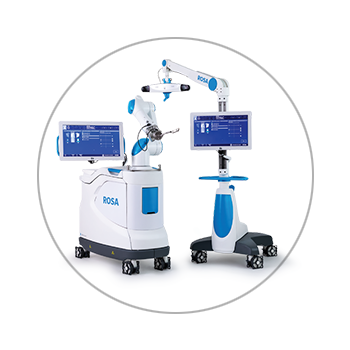

PUBLICATION
A new robotically assisted technique can improve outcomes of total knee arthroplasty comparing to an imageless navigation system
Mancino F, Rossi SMP, Sangaletti R, Lucenti L, Terragnoli F, Benazzo F. Arch Orthop Trauma Surg. 2022
Key Takeaway: Imageless robotic TKA demonstrates improved ROM and less pain at 12 months following TKA compared to imageless navigation.


PUBLICATION
Introduction of ROSA robotic-arm system for total knee arthroplasty is associated with a minimal learning curve for operative time
Bolam SM, Tay ML, Zaidi F, et al. Journal of Experimental Orthopaedics. 2022;9(1):86.
Key Takeaway: The most pertinent finding of this study was that there was a learning curve of between 5 and 15 cases associated with the introduction of this RA TKA system. There was no significant increase in operative time in the RA TKA group compared to the conventional TKA group. There were no post-operative complications associated with the introduction of this system.


PUBLICATION
An anatomo-functional implant positioning technique with robotic assistance for primary TKA allows the restoration of the native knee alignment and a natural functional ligament pattern, with a faster recovery at 6 months compared to an adjusted mechanical technique.
Parratte S, Van Overschelde P, Bandi M, Ozturk BY, Batailler C. Knee Surg Sports Traumatol Arthrosc. 2022.
Key Takeaway: Faster recovery using an anatomo-functional implant positioning (AFIP) technique for robotic total knee arthroplasty compared to an adjusted mechanical alignment (aMA) technique.
“The AFIP concept allowed the restoration of the native knee anatomy and alignment with a natural ligament pattern.
With a more physiological target for ligament balancing, robotically-assisted AFIP technique had equivalent clinical outcomes at 12 months compared to aMA, with a faster recovery”


PUBLICATION
Comparative outcomes between a new robotically assisted and a manual technique for total knee arthroplasty in patients with osteoarthritis: a prospective matched comparative cohort study.
Kenanidis E, Paparoidamis G, Milonakis N, Potoupnis M, Tsiridis E. European Journal of Orthopaedic Surgery & Traumatology. 2022.
Key Takeaway: raTKA was associated with the same complication risk, less pain level, better patient satisfaction, and PROMs on 6-month follow-up than the mTKA group.
“One of the first comparative clinical studies evaluating outcome differences between ROSA raTKA and mTKA”, and the “results indicate that raTKA may help enhance the early functional recovery of TKA patients and promote a better satisfaction level in the early postoperative period.”


PUBLICATION
Total Knee Arthroplasty With Robotic Surgical Assistance Results in Less Physician Stress and Strain Than Conventional Methods
Haffar A, Krueger CA, Goh GS, Lonner JH. 2022 Jun;37(6S):S193-S200.
Key Takeaway: Robotic assistance may help to increase surgical efficiency and reduce physician workload
Total energy expenditure was lower in robotic TKA than conventional TKA. Average heart rate was lower in robotic TKA. Robotic TKA resulted in less lumbar flexion and a reduction in the time spent in demanding lumbar flexion. Neck rotation was significantly reduced by robotic TKA.


PUBLICATION
Is sequential bilateral robotic total knee arthroplasty a safe procedure? A matched comparative pilot study.
Batailler C, Anderson MB*, Flecher X, Ollivier M, Parratte S. Archives of Orthopaedic and Trauma Surgery 2022.
Key Takeaway: Sequential bilateral TKA performed with robotic assistance more accurately restores knee alignment with similar perioperative outcomes and better Knee Society functional scores at six months postoperative compared to conventional instrumentation, despite a longer surgical time.
Bilateral sequential TKA is a valid option for improving accuracy and early outcomes, without posing an additional risk of complications.


PUBLICATION
A Personal Journey through, and review of, the Landscape of Surgical Robotics in Knee Arthroplasty: My Transition from Mako® to NAVIO™ and finally to the ROSA® Knee System+
Lonner H. Jess, Journal of Orthopaedic Experience & Innovation 2022.
Key Takeaway: The potential of the confluence of the ROSA Knee System and analytics platforms to simplify the surgical procedure, improve accuracy, and provide a vehicle for mass customization and individualization of care for each patient is a noteworthy advance.
Dr. Lonner concludes that the value of contemporary knee robotics may not yet be fully appreciated, which is emphasized by the prospects of advancing AI with pre, intra, and post-operative data in order to further optimize outcomes for TKA. He feels that robotics in arthroplasty is on the verge of becoming “self-evident”.


PUBLICATION
The initial learning curve for the ROSA® Knee System can be achieved in 6-11 cases for operative time and has similar 90-day complication rates with improved implant alignment compared to manual instrumentation in total knee arthroplasty.
Vanlommel, Luc, Enrico Neven, Mike B. Anderson*, Liesbeth Bruckers, Jan Truijen. Journal of Experimental Orthopaedics (2021) 8:119
Key Takeaway: The data demonstrated a relatively rapid learning curve for operative times associated with adoption of this novel robotic system.
As the digital age of medicine continues to develop, advanced technologies may disrupt the industry, but should not disrupt the care provided. This cutting guide positioning robotic system can be integrated relatively quickly with a rapid initial learning curve (6-11 cases) for operative times, similar 90-day complication rates, and improved component positioning compared to mTKA. Proficiency of the system requires additional analysis, but it can be expected to improve over time.


PUBLICATION
Using Standard X-ray Images to Create 3D Digital Bone Models and Patient-Matched Guides for Aiding Implant Positioning and Sizing in Total Knee Arthroplasty+
Massé, Vincent and Raju S. Ghate. Computer Assisted Surgery, 26:1, 31-40, published online 15 Mar 2021
Key Takeaway: X-Atlas™ imaging technology could effectively predict implant sizing.
The X-Atlas™ imaging technology proved to be accurate to reconstruct a 3D bone model and results have shown that it might provide benefits to surgeons seeking improved planning and precision without the problems of obtaining 3D imaging.


POSTER
High Interobserver Reliability of Bone and Soft Tissue Registration in A Robotic TKA Platform.
Charette, MD, Ryan S; Nana O. Sarpong, MD, MBA; Roshan P Shah, MD; Herbert John Cooper, MD. American Association of Hip and Knee Surgeons Annual Meeting. November, 2021. Poster 162
Key Takeaway: Registration of anatomic landmarks and dynamic soft tissue assessment can be performed with excellent reliability using the imageless version of ROSA.
There was excellent repeatability using imageless software between all evaluators and across all training levels (ρc>0.92). Image-guided specimens showed a greater correlation than imageless specimens (ρc >= 0.98). Measurements of maximum soft tissue laxity in medial and lateral flexion and extension spaces demonstrated the highest concordance (all ρc >0.99).


PUBLICATION
High accuracy of a new robotically assisted technique for total knee arthroplasty: an in vivo study.
Rossi SMP, Sangaletti R, Perticarini L, Terragnoli F, Benazzo F. Knee Surg Sports Traumatol Arthrosc 2022
Key Takeaway: The ROSA Knee system demonstrated a high degree of in vivo accuracy.
The average difference between planned and validated measures were below 1 mm or under 1 degree with SD < 1.
The average difference between planned HKA and measured was 1.2 ± 1.1 degrees.
“…using this new surgical robot in total knee arthroplasty [makes it] possible to perform accurate bone cuts and to achieve the planned angles and resections.”
ROSA® Hip System


PUBLICATION
Improved accuracy and fewer outliers with a novel CT‑free robotic THA system in matched‑pair analysis with manual THA+
Kamath, Atul, F., Sridhar M. Durbhakula, Trevor Pickering, Nathan L. Caferky, Trevor G. Murray, Michael A. Wind Jr., Stéphane Méthot*. Journal of Robotic Surgery. Published online: 28 October 2021.
Key Takeaway: ROSA Hip demonstrated more accurate acetabular cup positioning and resulted in fewer outliers compared to manual THA.
For all parameters studied – including cup inclination and version, leg length discrepancy and cup placement compared to target – the robotic group had an improved accuracy and lower variance (fewer outliers) vs conventional instrumentation.
SignatureTM ONE Surgical Planning
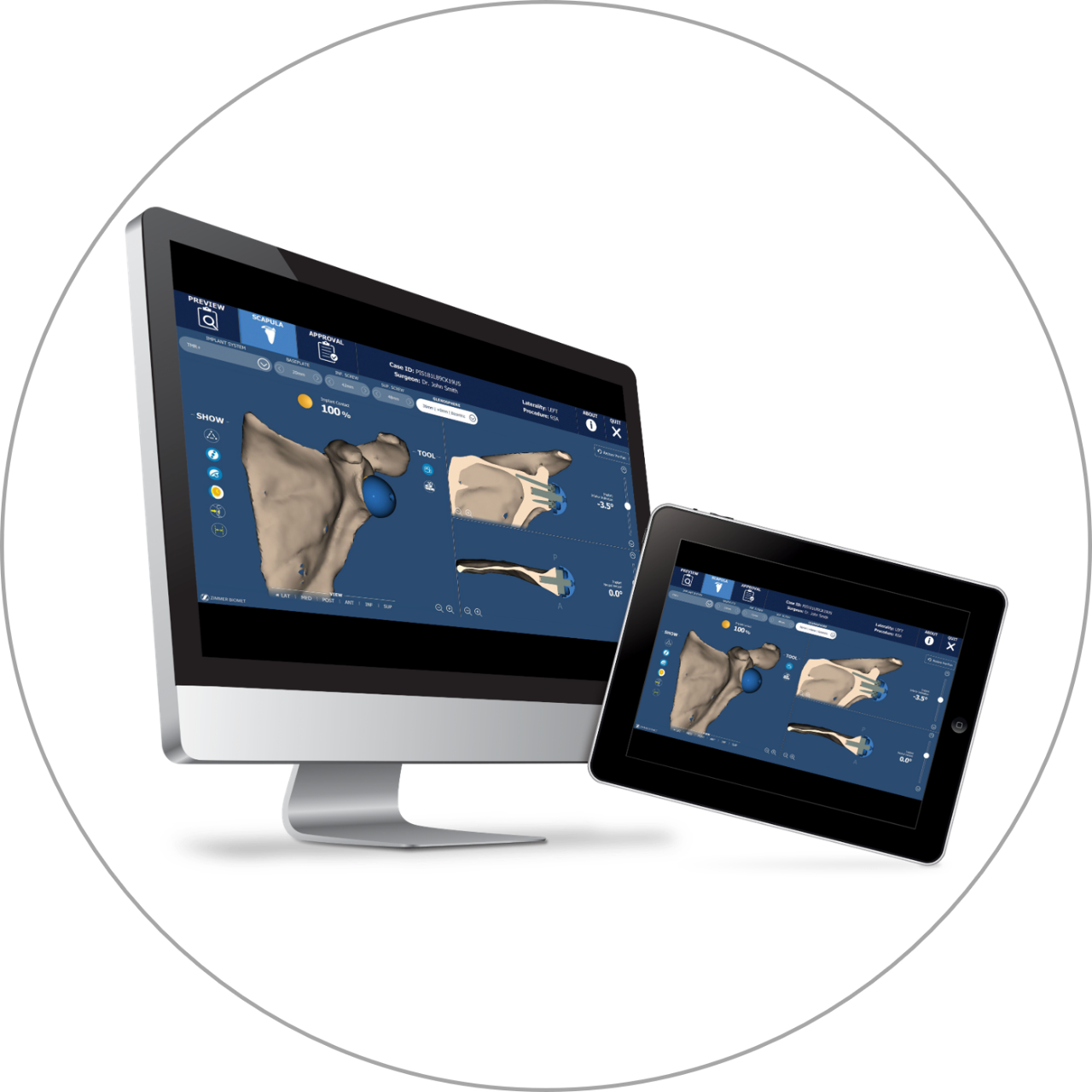

PUBLICATION
Patient-specific targeting guides compared with traditional instrumentation for glenoid component placement in shoulder arthroplasty: a multi-surgeon study in 70 arthritic cadaver specimens
Throckmorton, MD, Thomas W, Lawrence V. Gulotta, MD, Frank O. Bonnarens, MD, Stephen A. Wright, MD, Jeffrey L. Hartzell, MD, William B. Rozzi, MD, Jason M. Hurst, MD, Simon P. Frostick, MD, John W. Sperling, MD, MBA. J Shoulder Elbow Surg (2015).
Key Takeaway: Signature ONE planner and patient-specific guides were significantly more accurate (P=.01) for the combined vectors of version and inclination compared to conventional instruments.


PUBLICATION
Accuracy of 3-Dimensional Planning, Implant Templating, and Patient-Specific Instrumentation in Anatomic Total Shoulder Arthroplasty
Iannotti, MD, Joseph P., PhD, Kyle Walker, MD, Eric Rodriguez, MS, Thomas E. Patterson, PhD, Bong-Jae Jun, PhD, and Eric T. Ricchetti, MD. J Bone Joint Surg Am. 2019;101:446-57.
Key Takeaway: Signature preoperative planning and patient-specific instrumentation improves the accuracy of glenoid implant placement in TSA.
mymobility®
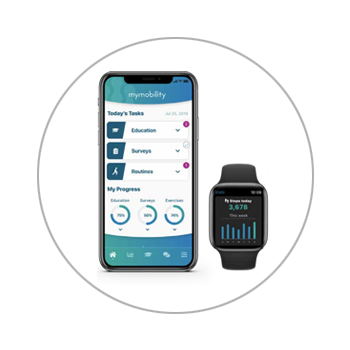

PUBLICATION
2021 Mark Coventry Award: Use of a Smartphone-Based Care Platform After Primary Partial and Total Knee Arthroplasty: A Prospective Randomized Controlled Trial+
Crawford, David et al. Bone Joint J 2021;103-B (6 Supple A) : 3-12
Key Takeaway: Equivalent outcomes and significantly fewer PT visits with mymobility for TKA/PKA
The purpose of this study was to determine the non-inferiority of a smartphone-based exercise educational care management system after primary knee arthroplasty compared with a traditional in-person physiotherapy rehabilitation model. The data found that mymobility is clinically non-inferior to the standard of care for all outcomes. mymobility users demonstrated a significant reduction of physical therapy utilization post-operatively. Further, mymobility users trended lower on ED visits than control group, though not statistically significant. This platform could aid in decreasing post-operative costs, while improving patient engagement and communication with the healthcare team.


PUBLICATION
Early Outcomes of Primary Total Hip Arthroplasty with Use of a Smartphone-Based Care Platform: A Prospective Randomized Controlled Trial+
Crawford, David et al Bone Joint J 2021;103-B (7 Supple B):91-97.
Key Takeaway: Equivalent outcomes and significantly fewer PT visits with mymobility for THA
The purpose of this study was to determine the non-inferiority of a smartphone-based exercise educational care management system after primary total hip arthroplasty compared with a traditional in-person physiotherapy rehabilitation model. The data found that mymobility is clinically non-inferior to the standard of care for all outcomes. mymobility users demonstrated a significant reduction of physical therapy utilization post-operatively. Further, mymobility users trended lower on ED visits than the control group and hospital readmissions, though not statistically significant. This platform could aid in decreasing post-operative costs, while improving patient engagement and communication with the healthcare team.


ABSTRACT
Feasibility of Passively Collected Gait Parameters Using a Smart-Phone Based Care Platform Following Total Hip and Knee Arthroplasty+
M. Anderson*, D. Van Andel*, J. Foran, I. Mance, E. Arnold. Orthopaedic Proceedings Vol. 103-B, No. SUPP_9, Published online 15 June 2021.
Key Takeaway: mymobility enables remote gait quality measurements
The purpose of this study was to assess the recovery of gait quality following primary total hip and knee arthroplasty using a smart-phone based care management platform. The recovery curves reflect previous curves captured by traditional gait analysis methods as well as functional and patient reported outcome scores. Capturing real-world gait quality metrics through the phone may provide further insights into objective recovery data not captured by traditional in-clinic assessments.


ABSTRACT
The Recovery Curve for Physical Activity Following Primary Knee Arthroplasty Using Passively Collected Objective Measures with a Smart-phone Based Care Platform and Smart Watch+
M. Anderson*, D. Van Andel*, C.L. Israelite, C. Nelson. Orthopaedic Proceedings. Volume 103-B, No. SUPP_9, Published online 15 June 2021
Key Takeaway: Objective and reliable data with mymobility
The purpose of this study was to characterize the recovery of physical activity following knee arthroplasty by means of step counts and flight counts (flights of stairs) measured using a smart-phone based care platform. This data demonstrated a recovery curve similar to previously reported curves for patient reported outcome measures in the arthroplasty arena. Patients and surgeons may use this information to help set goals for recovery following total and partial knee arthroplasty using objective activity measures.


WHITE PAPER
Technology Adoption for Health Care Management Among Older Adults: Embracing App-Based Technology as a Means for Better Managing Post-Operative Care After Arthroplasty
Zimmer Biomet, White Paper, March 2021.
Key Takeaway: Older adults adopt technology.
Older adults are demonstrating a continued and significant adoption of technology. Moreover, baby boomers are increasingly eager to have their health care needs managed through a combination of technology and traditional health care.
OrthoIntel Orthopedic Intelligence Platform




ABSTRACT
Passive Data Collection Across the 6-Week Episode of Care, the Next Evolution in Contemporary Patient Outcomes Monitoring in Total Knee Arthroplasty
Anderson, M.*, J. Lonner, D. Van Andel*, J.C. Ballard. Orthopaedic Proceedings. Volume 103-B, No. SUPP_9. Published online 15 June 2021
Key Takeaway: First-ever example of identifying treatment trends with combination of ROSA and mymobility data in a commercial database
The purpose of the study was to demonstrate the feasibility of passively collecting objective, anonymized data from a commercially available smartphone-based care management platform (sbCMP) and robotic assisted total knee arthroplasty (raTKA). The use of passively collected objective measures in a commercial database across the episode of care was feasible and demonstrated associations between intraoperative and post-operative metrics.
This is the first integrated data collection and reporting platform to demonstrate these measures in a commercial population.
OptiVu™ Mixed Reality
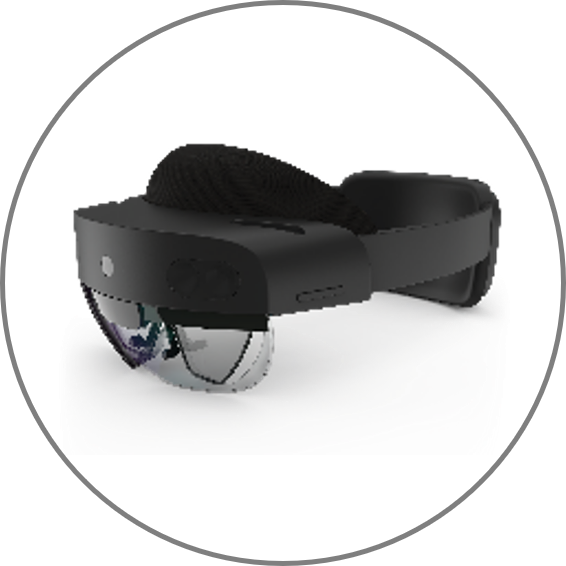
PUBLICATION
Looking through the Lens: The Reality of Telesurgical Support with Interactive Technology Using Microsoft’s HoloLens 2.
Kees van der Putten*, Mike B. Anderson*, and Rutger C. van Geenen. Case Reports in Orthopedics, vol. 2022, Article ID 5766340, 5 pages, 2022.
Key Takeaway: Microsoft HoloLens 2 was used for unplanned remote assistance for telesurgical support.
This case study demonstrates the ability to use the HoloLens 2 with Microsoft Dynamics 365 Remote Assist Software to provide immediate telesurgical support by an industry representative, the PM, to the operating surgeon approximately 100 km apart. The data is transferred via an encrypted and secured cloud-based program and provided the PM a real-time surgeon viewpoint of the operating theatre, including direct line of site to the operative knee, the operating instruments, and even the surgeon’s hands.